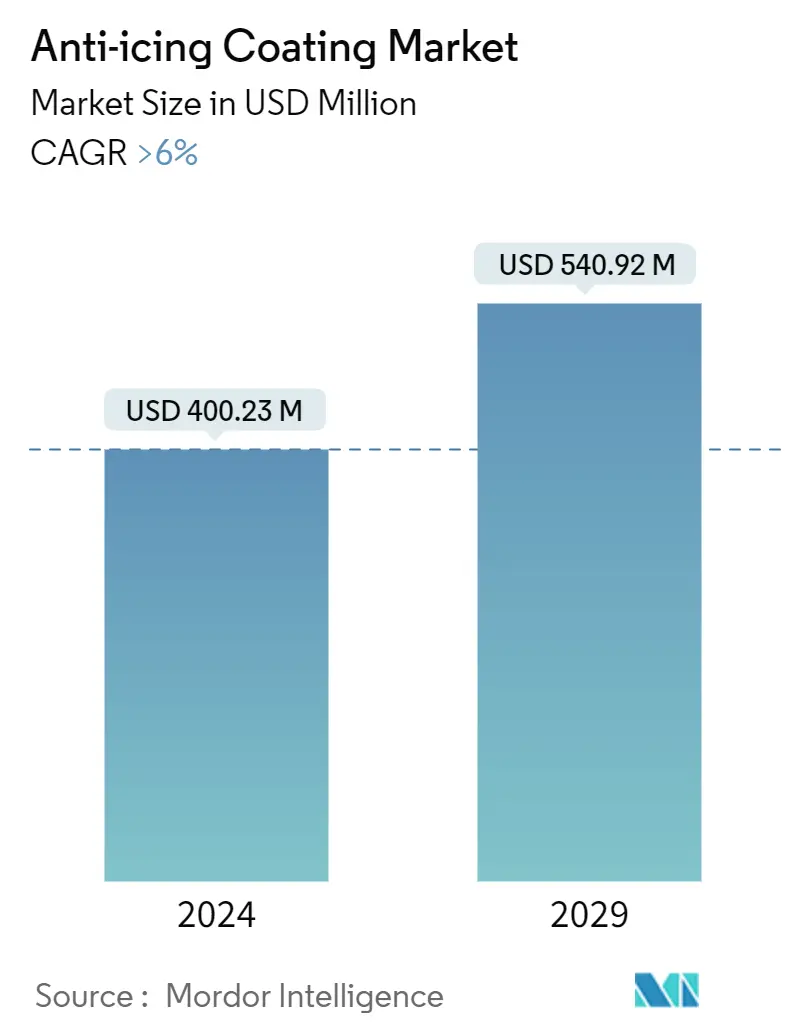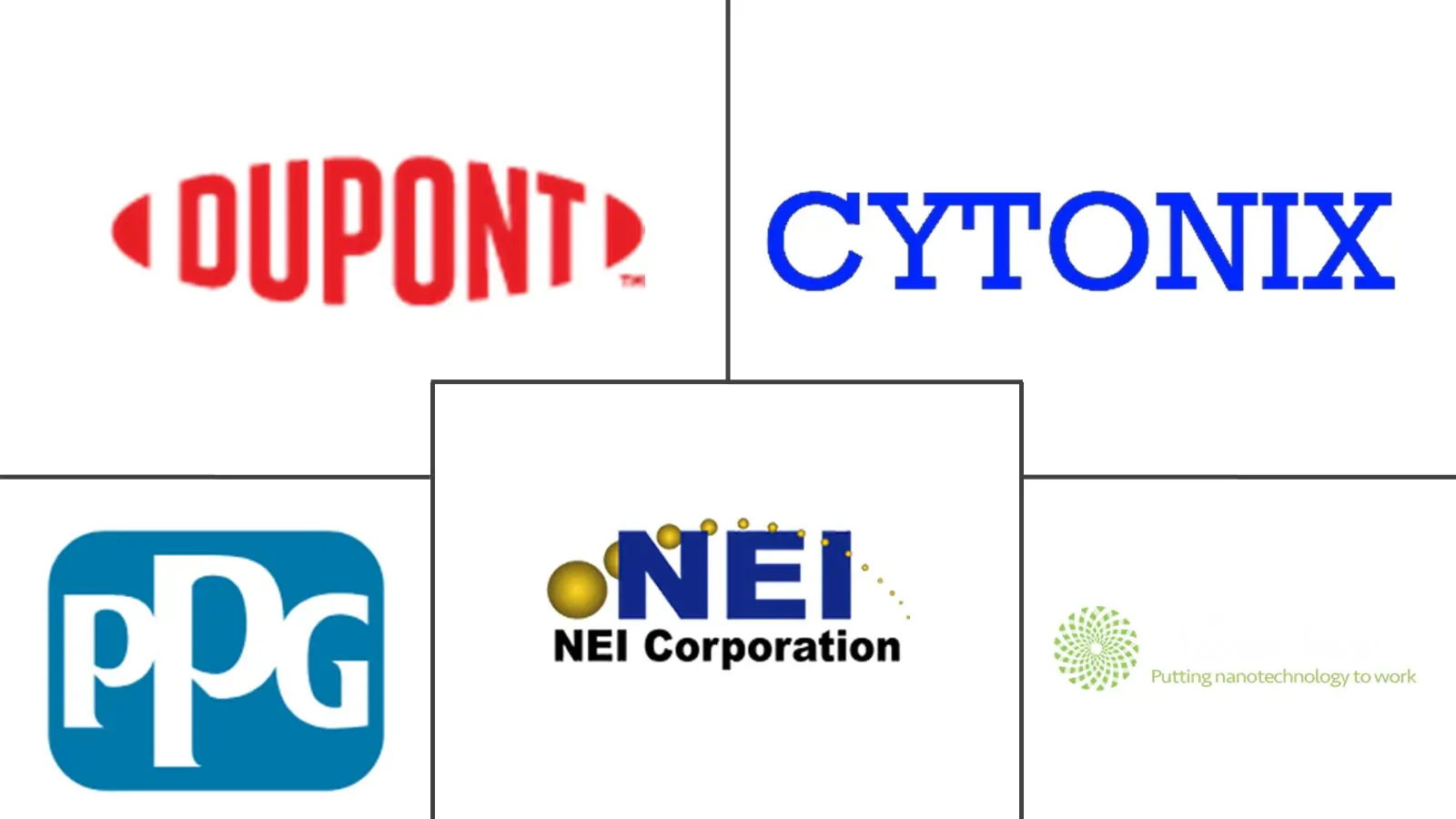Market Size of Anti-icing Coating Industry

| Study Period | 2019-2029 |
| Market Size (2024) | USD 400.23 Million |
| Market Size (2029) | USD 540.92 Million |
| CAGR (2024 - 2029) | > 6.00 % |
| Fastest Growing Market | North America |
| Largest Market | Europe |
| Market Concentration | Low |
Major Players
*Disclaimer: Major Players sorted in no particular order |
Anti-Icing Coating Market Analysis
The Anti-icing Coating Market size is estimated at USD 400.23 million in 2024, and is expected to reach USD 540.92 million by 2029, growing at a CAGR of greater than 6% during the forecast period (2024-2029).
- The COVID-19 pandemic negatively impacted the market due to worldwide lockdowns, strict social distancing measures, and disruptions in supply chains, which had adverse effects on the market for anti-icing coatings. The prices of raw materials increased during the lockdown, further contributing to the negative impact on the anti-icing coatings market.
- However, the market recovered well after the restrictions were lifted. It rebounded significantly, driven by increased consumption of anti-icing coatings in the automotive, transportation, construction, telecommunication, and renewable energy industries.
- The growing demand from the automotive and aerospace sectors, high demand in cold climatic conditions, and the superior properties of anti-icing coatings are expected to drive the market for anti-icing coatings.
- The availability of cost-effective alternate substitutes for anti-icing coatings is expected to hinder market growth.
- The development of a self-sustainable lubricating anti-icing layer is expected to create opportunities for the market during the forecast period.
- The European region dominates the market, owing to the growing application of anti-icing coatings in cold climatic conditions in the region, which augments the demand for anti-icing coatings.
Anti-Icing Coating Industry Segmentation
Anti-ice coatings impart anti-icing properties to the underlying substrate, reducing ice adhesion by up to 80% and thereby preventing dangerous ice build-up. The nanocomposite coatings are hard and transparent while providing a smooth and glossy finish with low haze.
The anti-icing coating market is segmented by substrate and end-user industry. By substrate, the market is segmented into metal, glass, ceramics, and concrete. By end-user industry, the market is segmented into automotive and transportation, construction, telecommunication, renewable energy, and other end-user industries ( marine, industrial, etc.). The report also covers the market sizes and forecasts for the anti-icing coating market in 11 countries across the significant region.
For each segment, the market sizing and forecasts have been done based on value (USD).
| Substrate | |
| Metal | |
| Glass | |
| Ceramics | |
| Concrete |
| End User Industry | |
| Automotive and Transportation | |
| Construction | |
| Telecommunication | |
| Renewable Energy | |
| Other End-User Industries (Marine, Industrial, etc.) |
| Geography | |||||||
| |||||||
| |||||||
| |||||||
|
Anti-icing Coating Market Size Summary
The anti-icing coating market is poised for significant growth, driven by its increasing application across various industries such as automotive, transportation, construction, telecommunications, and renewable energy. The market experienced a downturn due to the COVID-19 pandemic, which disrupted supply chains and increased raw material costs. However, it has since rebounded, with the automotive and aerospace sectors playing a pivotal role in this recovery. The demand for anti-icing coatings is particularly strong in regions with cold climates, where these coatings are essential for enhancing the performance and safety of vehicles and infrastructure. Despite the presence of cost-effective alternatives that may hinder growth, innovations like self-sustainable lubricating layers present new opportunities for market expansion.
Europe is expected to dominate the anti-icing coating market, driven by its robust automotive and construction industries, as well as the growing demand for wind energy. The region's cold climate necessitates the use of anti-icing coatings, particularly in countries like Germany and France, where automotive production is significant. The increase in air traffic and the subsequent demand for new aircraft further bolster the market in Europe. Additionally, the wind energy sector's expansion, with Europe aiming to install substantial new capacity, underscores the importance of anti-icing coatings in maintaining the efficiency and reducing maintenance costs of wind turbines. The market is characterized by a partial consolidation, with key players such as NEI Corporation, Cytonix, PPG Industries, Inc., DuPont, and NanoSonic, Inc. leading the charge in innovation and development.
Anti-icing Coating Market Size - Table of Contents
-
1. MARKET DYNAMICS
-
1.1 Drivers
-
1.1.1 Growing demand from Automotive and Aerospace Sector
-
1.1.2 High Demand in Cold Climatic Conditions
-
1.1.3 Superior Properties of Anti-icing Coatings
-
-
1.2 Restraints
-
1.2.1 Availability of Cost-Effective Alternate Substitutes
-
1.2.2 Other Restraints
-
-
1.3 Industry Value Chain Analysis
-
1.4 Porter's Five Forces Analysis
-
1.4.1 Bargaining Power of Suppliers
-
1.4.2 Bargaining Power of Buyers
-
1.4.3 Threat of New Entrants
-
1.4.4 Threat of Substitute Products and Services
-
1.4.5 Degree of Competition
-
-
-
2. MARKET SEGMENTATION (Market Size in Value)
-
2.1 Substrate
-
2.1.1 Metal
-
2.1.2 Glass
-
2.1.3 Ceramics
-
2.1.4 Concrete
-
-
2.2 End User Industry
-
2.2.1 Automotive and Transportation
-
2.2.2 Construction
-
2.2.3 Telecommunication
-
2.2.4 Renewable Energy
-
2.2.5 Other End-User Industries (Marine, Industrial, etc.)
-
-
2.3 Geography
-
2.3.1 Asia-Pacific
-
2.3.1.1 China
-
2.3.1.2 India
-
2.3.1.3 Japan
-
2.3.1.4 South Korea
-
2.3.1.5 Rest of Asia-Pacific
-
-
2.3.2 North America
-
2.3.2.1 United States
-
2.3.2.2 Canada
-
2.3.2.3 Mexico
-
-
2.3.3 Europe
-
2.3.3.1 Germany
-
2.3.3.2 United Kingdom
-
2.3.3.3 Italy
-
2.3.3.4 France
-
2.3.3.5 Rest of Europe
-
-
2.3.4 Rest of the World
-
2.3.4.1 South America
-
2.3.4.2 Middle-East and Africa
-
-
-
Anti-icing Coating Market Size FAQs
How big is the Anti-icing Coating Market?
The Anti-icing Coating Market size is expected to reach USD 400.23 million in 2024 and grow at a CAGR of greater than 6% to reach USD 540.92 million by 2029.
What is the current Anti-icing Coating Market size?
In 2024, the Anti-icing Coating Market size is expected to reach USD 400.23 million.

